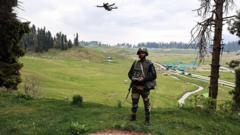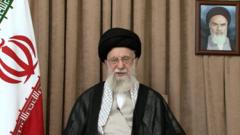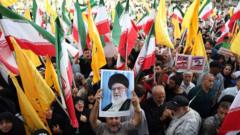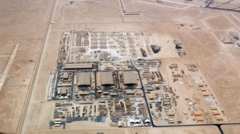As tensions escalate between India and Pakistan, the two countries have entered what experts describe as the world's first drone war, exchanging unmanned aerial strikes amidst ongoing military clashes, prompting fears of a larger conflict.
Escalation in Indo-Pak Relations: The Dawn of Drone Warfare

Escalation in Indo-Pak Relations: The Dawn of Drone Warfare
A new era in the Indo-Pak conflict has begun as drone warfare takes center stage in exchanges between the two nuclear-armed nations, raising global concerns.
The first drone war unfolds between two nuclear-armed nations, marking a significant new phase in the enduring conflict between India and Pakistan. On Thursday, India accused Pakistan of initiating a series of drone and missile strikes targeting Indian military installations in territories it administers, a claim Islamabad immediately refuted. Pakistan, meanwhile, reported the downing of 25 Indian drones in its airspace, leaving India to maintain a rare silence regarding these allegations.
Experts have warned that these back-and-forth exchanges signify a dangerous evolution of this decades-long rivalry, as both countries now employ unmanned aircraft in their military strategies along a delicate and often volatile border. Jahara Matisek, a professor at the US Naval War College, emphasized that this shift to drone engagement could redefine battlefield dynamics with unmanned weaponry becoming crucial for both sides.
Since the previous day, Pakistan has reported casualties of 36 dead and 57 injured due to cross-border fire and airstrikes initiated by India, while Indian authorities claim 16 civilians lost their lives from Pakistani shelling. India justified its military response as an act of retaliation to an attack on Indian tourists in Pahalgam last month, an incident Pakistan has denied involvement in.
In a show of strength, Pakistan claimed to have intercepted 25 Indian drones in several cities, identifying them as Israeli-made Harop drones. While India contends that it has successfully neutralized multiple Pakistani radar and defense systems, Pakistan dismissed these assertions.
The advent of drones into the conflict is reshaping military operations significantly. Drones can facilitate precise engagements, act as decoys, and enhance airstrikes targeting capabilities. Matisek pointed out that this developing warfare dynamic resembles strategies evident in the Ukraine-Russia conflict, where drones operate as tools to trigger responses without deploying traditional armed aircraft.
India's drone fleet, primarily composed of Israeli models such as the IAI Heron and Harop, showcases the country’s intent to leverage UAV technology for strategic advantages. Aside from enhancing reconnaissance, India's recent multi-billion-dollar purchase of US MQ-9B Predator drones represents a notable increase in its aerial strike capabilities.
On the other hand, Pakistan's drone arsenal, which includes technology from China and Turkey, is also extensive. The focus on integrating unmanned systems suggests a concerted effort to match India’s advancements in drone warfare.
Despite the growing presence of drones, experts caution that the exchanges between the nations do not yet match the comprehensive drone warfare seen in other conflicts. Manoj Joshi, an Indian defense analyst, highlighted that while drones serve as a “lower-level military option” compared to heavier munitions, the situation could swiftly escalate.
The trajectory of this new chapter in the ongoing conflict could either trend towards de-escalation or further escalation, with both outcomes still very much in play. Matisek remarked that although integrating drones provides new operational options, it simultaneously creates potential flashpoints for conflict, especially when nations with nuclear capabilities are involved.
In this tenuous situation, the implications for peace and security in South Asia hang in the balance, making the future of Indo-Pak relations increasingly uncertain.





















